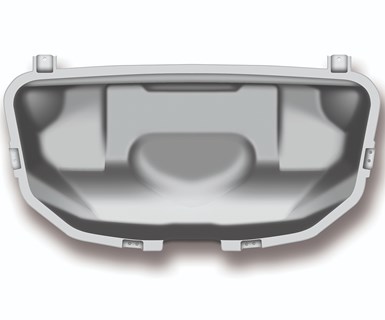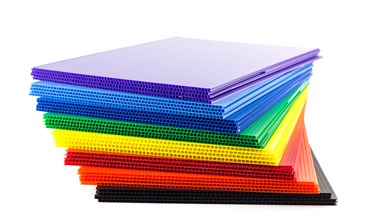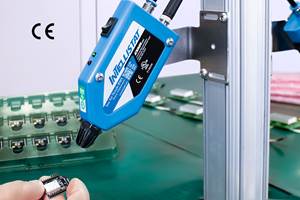
Hapsoft PP compounds are featured in the center floor console trim, front-seat back boards and instrument-panel trim of the 2020 Land Rover Defender.
While polypropylene encompasses a widely diverse range of properties and uses, two themes characterize the new generation of higher-performing PP resins and compounds. One is competitive inroads against not only other commodity resins like PS and PET, but also more expensive engineering polymers like nylons and PC. The other is a significant push for sustainability—without compromised performance. Newer offerings embodying these trends include grades that extend lightweighting opportunities such as foamed PP, short- and long-glass reinforced compounds, carbon-fiber reinforced PP, and grades with recycle content or made with biobased feedstock.
Within the last couple of years, we have reported on PP suppliers and compounders that have acquired recycling companies, such as Borealis and Albis Plastics. We have also reported on strides made to produce PP from biobased propane. Borealis is now commercially producing PP based on renewable feedstock made with the proprietary Nexblt technology of Findland’s Neste at two Belgian facilities. Last year, LyondellBasell was the first to successfully produce biobased PP and LDPE in parallel using Nexbtl technology, and is now validating market demand for these products.
Sustainable PP
As previously reported, SABIC’s Trucircle portfolio includes its new certified-renewable, virgin PP polymers based on second-generation, animal-free, biobased feedstock such as waste from wood pulping. Trucircle also includes grades for designing for recyclability to help minimize waste and encourage recycling, as well as mechanically recycled products and certified circular products from feedstock of mixed plastic waste.
Braskem’s I’m Green brand of PE and PP includes biobased resins, post-consumer recycled (PCR) resins, as well as mixed biobased plastics and PCR offerings, though the company has yet to produce I’m Green PP on an industrial scale. In July, Braskem became the lead founding member of the PP Recycling Coalition, aimed at improving PP recovery and recycling in the U.S.
Weighing in on new and future PP developments are three leading PP resin producers—ExxonMobil Chemical, SABIC and Braskem—and two major “engineering” compounders—RTP Co. and Albis Plastics.

The reusable Tupperware EcoStraw and a new drinking tumbler are both made from SABIC’s certified circular PP polymer that is derived from a feedstock of mixed plastic waste.
Performance PP for Automotive & More
Advanced PP materials for automotive appear to dominate the newest developments. Says an RTP source, “As resin manufacturers continue to improve the properties of neat PPs, compounders can utilize those improved grades to push the properties of PP-based compounds like TPOs For example, new high-flow copolymer PPs are achieving better and better impact-resistance and flexural-modulus balances, which can be improved further through the addition of modifiers or mineral fillers.”
Two new performance grades launched by ExxonMobil both address the ongoing drive to reduce vehicle weight by enabling thinner, lighter parts while maintaining impact performance and rigidity, says Olivier Lorge, global market manager for PP, Vistamaxx and Adhesions business. New Achieve Advanced PP7925E1 for North America and ExxonMobil PP7495E1 for Asia-Pacific have been designed to meet the specification preferences of customers in their respective regions. Offering 100 MFR or higher flow, both grades allow efficient molding of thinner parts. Further innovation in this area is expected as lightweighting continues to be a goal for both internal-combustion and electric vehicles, notes Lorge.
As an example, Lorge points to the large lift gates on popular crossover SUVs, which are increasingly made of PP/glass-fiber composites instead of steel. He expects that electric vehicles will only extend PP’s inroads. “One result of the move to electric vehicles is the removal of a high-heat source, the internal-combustion engine (ICE), which allows PP to replace engineering resins and metals under the hood and, perhaps like the lift-gate example, in the hood itself. Even in ICE vehicles, downsizing provides opportunities to increase the use of PP in applications such as the intake manifold and engine cover. Plus, low temperature LEDs allow the use of more PP in lamp housings, even when they are in ‘all-time-on’ mode.”
PP is increasingly challenging higher-cost resins like nylons and PC.
SABIC’s PP business global director, Lada Kurelec, points to the company’s new halogen-free flame-retardant PP compounds with short and long glass reinforcement that provide low-density solutions in demanding applications. With good temperature resistance and electrical and mechanical performance, the compounds are suitable for components in automotive as well as electrical/electronic (E&E), building construction, and appliances. These materials boast a remarkable combination of processability and mechanical and electrical properties, as well as a low flammability rating. Components made from these compounds are aimed at E&E applications including electric-vehicle power trains and charging infrastructure as well as miniature circuit breakers, distribution boxes, connectors, switches and sockets, power-tool housings, and structural parts in building construction. This portfolio targets the need for materials with continuous-use temperatures in the range of 100 C/212 F, sufficient to replace nylon 6 and 66.
SABIC has launched Hapsoft S3615, S3620 and S3625 PP compounds that can deliver soft-feel haptics with excellent scratch resistance for unpainted, low-gloss applications. These injection molding grades boast luxurious haptics and finishes and can help manufacturers reduce costs by as much as 50% by avoiding secondary operations. Applications include auto interiors, small appliances and consumer electronics.
Through a recent collaboration with Portugal’s Solaris-Protevs, SABIC supplied a specialty PP compound for the injection molded floaters in Solaris-Protevs’ floating solar-panel system. These lightweight, high-stiffness floating solar panels can be placed on inland water surfaces, such as lakes, and can connect to the electrical grid, providing a renewable energy source to cities.

A SABIC specialty PP compound is used to mold the floats for Solaris-Protev’s floating solar-panel system.
Albis Plastics is now operating under the new Mocom brand, as parent company Otto Krahn Group has separated its compounding business and its resin distribution businesses (retaining the Albis brand) to operate as two separate companies. According to Bernd Sparenberg, v.p. of global sales & market development, new and future performance PP compounds include closing the gap between standard PP and nylon 6. Included are the Altech NXT PP, short-glass compounds with high stiffness, lower density, great chemical resistance, lower moisture absorption, and heat aging of 2000 hr at 150 C/302 F. A recent application for a UV-stabilized NXT PP is the trunk opener of a new VW SUV.
Another Mocom highly engineered family is the Alcom LB PP compounds designed to replace PC in reflector and LED housings such as in auto instrument clusters. Alcom LB PP is said to enable separation of different light sources in a confined space. The material has light transmission values of <0.2% at 0.5 mm, light reflection level up to 97%, excellent flow, high thermal stability, nice strength and stiffness balance, high dimensional stability and low warpage. A current automotive application is a Honda reflector that is said to offer high opacity at thin-wall thickness, high reflection level and increased light output. The new PP compounds are also aimed at E/E, appliance, consumer goods, healthcare and lawn & garden applications.
In cooperation with sister company Wipag (a German plastics recycler), Mocom also offers recycle-content compounds, including Altech Eco Near-to-Prime PP compounds, Altech IQ (Industrial Quality) grades, Wipelast PP/EPDM, and Wipaflex PP/PE/EPDM, primarily targeted to automotive
RTP sources say compounds such as long-glass and short-carbon-fiber PP make a lot of sense in automobile designs where additional fuel economy or range--as in the case of electric vehicles—are primary concerns. RTP expects long-glass PP to see further growth due to the continued shift to lighter and more environmentally friendly materials as replacements for heavier engineered compounds like short-glass nylon or PBT. Mocom is running trials with post-industrial recycled PP with 30% long glass. One project underway is the tailgate of VW’s ID3 electrical vehicle.

RTP sources say PP compounds with long glass or short carbon fiber make a lot of sense in automobile designs for additional fuel economy or range—as in the case of electric vehicles, such as this “frunk” component.
RTP also recently developed a new line of short-carbon-fiber PP compounds, paving the way for even lighter parts when lightweighting demands justify the cost of carbon fiber. Mocom is also working on carbon-fiber PP compounds called WIC PP, for applications where up to 60% glass-filled nylon 6 is currently used. The key is the use of lower-cost recycled carbon fiber provided by sister company Wipag. The recycled carbon fiber costs less than 10% of prime fiber. One application is the filler-cap hinge arm on a BMW Audi, where WIC PP 30 replaced 50% glass-filled nylon 6, offering a weight and cost reduction of 32%. Another is Porche’s new electric Taycan vehicle, where WIC PP is replacing glass-filled nylon 6 and 66 in dashboards and trunk-support beams.
Foamed PP Poised for Wide-Ranging Growth
Whether for packaging, automotive, building construction or consumer goods, traditional solid materials are moving towards lightweight foamed structures. SABIC’s Kurelec says the next generation of thermoplastic foam solutions with improved dimensional stability and stiffness and less warpage are produced by a number of processing technologies that are in a state of continuing evolution and innovation.
Historically, foam applications have been dominated by amorphous polymers such as PS, PUR and PVC. Foamed semicrystalline PP is a relatively recent arrival, which has not gained large commercial traction, says ExxonMobil’s Lorge. Last month, the company launched foamable Achieve Advanced PP6302E1, described as an easily processed, sustainable solution for high-volume applications. This new high-melt-strength (HMS) PP delivers up to 30% higher stiffness than standard HMS PP foam, enabling significant cost reductions in a range of applications.

In industrial packaging, ExxonMobil’s Achieve Advanced PP6302E1 foamable PP boasts toughness and strength, temperature stability, moisture and chemical resistance, and light weight.
PP6302E1 is recyclable and enables less material use. “With PS foam, VOCs and monomer concerns being increasingly regulated, PP6302E1 is a viable alternative and, importantly, is processable on PS foam lines with varied blowing agents,” says Lorge. Processors, brand owners and OEMS can unlock opportunities in applications that benefit from lightweighting and insulation while leveraging PP properties:
▪ In food and beverage packaging—meat trays, microwaveable bowls/meals/trays, clamshells, and cups—PP6302E1 reportedly delivers improved stiffness and reduced cost, along with excellent insulation properties, good recyclability, and durable grease and moisture resistance even at high temperatures in microwave ovens and dishwashers. The packaging retains internal contents temperature during transit and offers comfort-touch surfaces.
▪ In industrial packaging—boxes, dividers, and sheets—PP6302E1 boasts toughness and strength, temperature stability, moisture and chemical resistance, and light weight. The stiff and durable packaging can be re-used and is well-suited to replacing corrugated sheet to protect valuable materials.
▪ In construction products—insulation and concrete joints—PP6302E1 reportedly delivers durability and flexibility for ease of installation. The products are thermally stable over a broad temperature range and moisture resistant for dimensional stability.
▪ In automotive components--headliners, ducts, floor liners—PP6302E1 boasts improved stiffness enabling manufacturers to maintain performance properties while reducing weight and increasing fuel efficiency.
Heat resistance for microwavability favors foamed PP over PS in food packaging.
Adds ExxonMobil’s Lorge, “Heat resistance for microwaveability continues to be a key differentiating factor that makes foamed PP an attractive choice over PS in food packaging. Compared with paper, PP6302E1 offers affordable insulation performance for a better consumer experience in packaging applications. Toughness/stiffness also help with durability so that products can be reused.”
SABIC’s Foam Innovation Center in The Netherlands is equipped with foam processing capabilities and analytical equipment, enabling SABIC to carry out developments on new foam technology and collaborative projects with value-chain partners to reduce material footprint, enable energy and cost reductions, and slash time to market. “Close collaboration with our customers has enabled SABIC to build up a large bank of knowledge on the various foaming processes, and to develop a dedicated, diverse foam portfolio, applicable in almost all end applications,” says Kurelec.
Among these new foam solutions is SABIC PP-UMS (Ultra Melt Strength) foamable PP resin. Said to be unique in the market, it reportedly offers excellent foamability with potential cost savings due to efficient processing, and meets stringent industry emissions requirements. Its light weight and insulating properties are said to be attractive for automotive, packaging, and building construction.
Next-Generation PP for Packaging
Polypropylene suppliers say sustainability concerns are motivating a big shift from PS to PP for injection molded rigid packaging. According to SABIC’s Kuralec, PP and PP foam are compatible with recycling systems using float/sink separation because of PP’s lower density than PS, which would sink and risk contaminating PET bottle recycling streams.
Unlike PS, PP’s lower density enables float-sink separation of PP from PET for recycling.
SABIC has launched Flowpact FPC75, a new phthalate-free PP impact copolymer for injection molding. The material is said to offer downgauging and faster processing for food and non-food thinwall packaging.
Braskem recently launched a new Inspire thermoforming grade that can replace PET. The new grade boasts optical properties similar to PET with better heat resistance than PET or PP random copolymer. It is targeted to applications which demand a great balance of clarity and heat resistance, such as store and restaurant pre-prepared and ready-to-heat meals. The improved heat resistance allows these containers to be cleaned in the dishwasher for reuse.
Braskem also has a new PCR homopolymer PP said to be well suited for compounding and uses in packaging, automotive, housewares and consumer goods.
SABIC has a new heterophasic impact PP for flexible packaging. SABIC PP BCT18F is targeted for use in lamination films in retort food packaging. Recent customer trials confirmed its very good processing and performance properties in all film extrusion processes including cast, blown and tenter-frame production lines. Also, this grade offers very good impact strength at low temperature (-20 C/-4 F_) for frozen-food packaging and outperforms comparable materials in the market.
Also new from SABIC is high-stiffness PP 5212P for BOPP films for labels, tape and food packaging such as confectionary, snacks, baked goods, dried fruits, pasta, and fresh-food packaging. Its broad molecular-weight distribution is said to enable easy processing with reduced film breaks in high-speed production up to 1722 ft/min. It reportedly offers an optimized MFR and high stiffness and barrier properties.
ExxonMobil is also exploring new combinations of its existing portfolio, says Lorge. For example, the combination of ExxonMobil PP2252 PP with Exceed XP performance PE raises the bar on blown films by allowing the fabrication of films with higher dart-drop impact resistance, creep improvement, and reduced film deformation due to shrinkage. The high-temperature resistance and shrink performance creates opportunities for compression liners, hot-fill packaging, and stand-up pouches.
Related Content
INEOS Styrolution to Close ABS Production in Addyston, Ohio
Company will commence a safe and responsible decommissioning process in the second quarter of 2025.
Read MoreOCSiAl Opens First Large-Scale Graphene Nanotube Plant
The new facility in Serbia will serve Europe, North America and Asia to drive advances in plastics and rubbers.
Read MoreNew Cleanroom-Rated Static Eliminator
Neutralize static hands-free in sensitive medical, pharmaceutical and electronic manufacturing operations.
Read MoreTransluscent Colorants for Injection Molded Parts
Ampacet’s Artemis masterbatch collection evokes the beauty of celestial phenomena.
Read MoreRead Next
Borealis Pushes PP In Automotive Development Projects
New high-fluidity PP grades from Borealis applied to new vehicles from the Renault-Nissan Alliance exemplify the trend of using a focused PP product portfolio on common global OEM platforms.
Read MoreSee Recyclers Close the Loop on Trade Show Production Scrap at NPE2024
A collaboration between show organizer PLASTICS, recycler CPR and size reduction experts WEIMA and Conair recovered and recycled all production scrap at NPE2024.
Read More





























